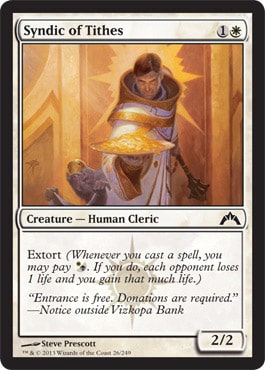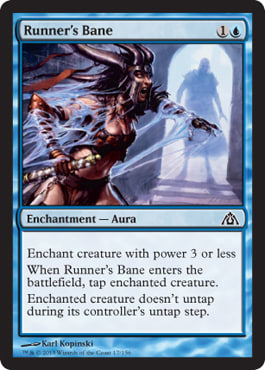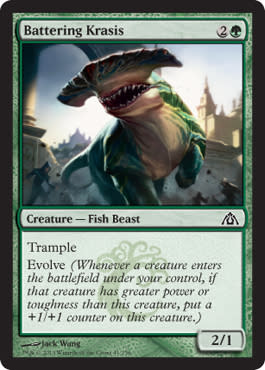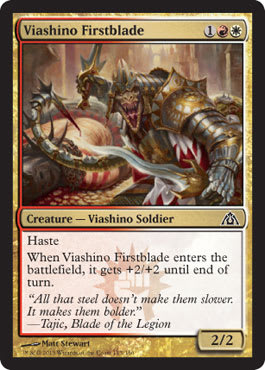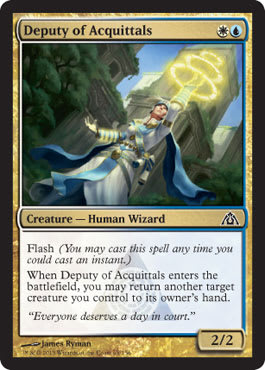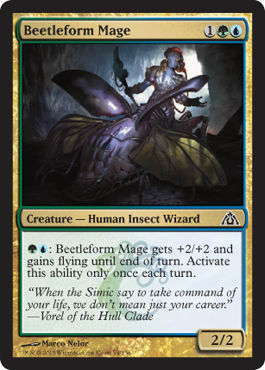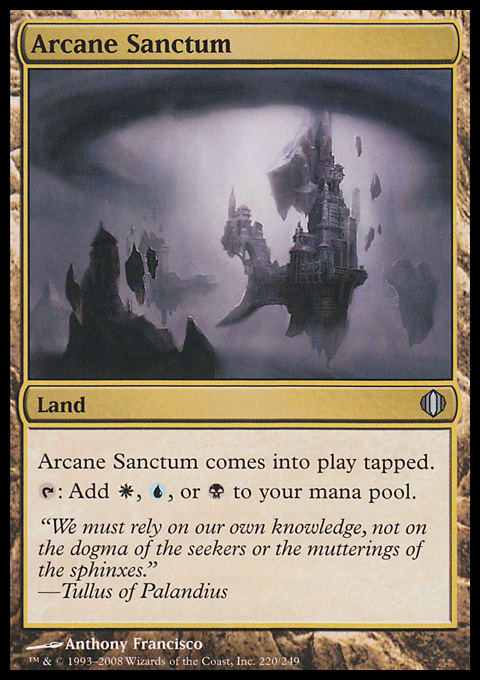With the Dragon’s Maze prerelease behind us, the excitement for this Friday’s release (and first looks into Standard and Limited) is growing. I’m looking forward to what those on top of their game bring to Pro Tour: Dragon’s Maze in a couple weeks, but there’s a more pressing matter at hand: I’ll be travelling to the event.
Travel itself isn’t what’s pressing, but the goal of getting the Pauper Cube updated before hitting the sunny city of San Diego. Priorities, you know.
This update will be a little different from the Gatecrash Pauper Cube update since the overall size of the changes is small. To balance that out, I have some thoughts on cards that almost made the cut and why you might consider them instead for your Cube.
For reference, the complete change log is always updated first as part of the Pauper Cube spoiler. I’ll provide the table at the end of this article as well.
White
Syndic of Tithes replaces Amrou Seekers.
I enjoy Amrou Seekers. It’s nontraditional evasion that can surprise players unfamiliar with Time Spiral. However, it’s also in a color filled with evasion (flying) and is weaker than its misbegotten Portal Three Kingdoms sibling Shu Cavalry. Syndic of Tithes doesn’t have evasion, but it’s a stellar way for aggressive W/B decks to pack both reach and ways to get ahead in a damage race. Being a 2/2 makes trading relevant as well.
There are two Dragon’s Maze cards I want to touch on, however. Lyev Decree is certainly an attractive spell. 2 mana takes care of two creatures for two turns—yours the turn you cast it, and your opponent’s that follows. There are two similar spells in Magic that I compared this to: Frost Breath and Blinding Beam. The differences are clear, too:
- Lyev Decree is not an instant, but it is the cheapest at just

 .
. - Lyev Decree has similar benefits to Frost Breath, but it interferes more with potential blockers than with attackers.
- Lyev Decree has similar benefits to Blinding Beam, but Blinding Beam can pin down a much larger portion of opponent’s creatures since it doesn’t target for its second ability.
Frost Breath made its exit in the last update, and Blinding Beam’s ability is often game-ending when played correctly. By the time an aggressive white deck would have an army to punch with, Blinding Beam is just as easy to cast as Lyev Decree. The importance of the effect is minimal since white already has plenty of sorcery-speed (Aura-based) removal.
The other interesting option is Steeple Roc. Traveling through Pauper history, Lorwyn’s Plover Knights cut an impressive standard for 3/3 with first strike and flying. Proving exceptionally powerful in Limited, Dark Ascension revised this down to a 3/2 body with Silverclaw Griffin. Dragon’s Maze shifts this further to give us Steeple Roc’s 3/1 body—but we finally receive a benefit since the double-white requirement to cast is gone. If you want powerful offensive and defensive flying creatures but struggle with double-white requirements in spells, Steeple Roc fills your need precisely.
Blue
Runner's Bane replaces Prohibit.
I did a quick check to calculate the average power of creatures in the Cube: It’s just above 2. Alternatively, there are nearly a hundred fifty creatures with 3 or less power—about 70% of all creatures. It’s conditional removal, but it’s still cheap and effective against a majority of creatures. After testing Prohibit, it turned out that 2 mana for a 2-mana spell—and 4 mana for a 3- or 4-mana spell—was too prohibitive.
Like white, there is another card that seems to have potential: Hidden Strings. Casting it and then being able to cipher it in the same turn is obviously powerful. It’s effectively a tempo spell that pulls you ahead in the race to use mana. However, it isn’t a defensive spell. Tapping the opponent’s permanents on your turn is wasteful if they don’t stay tapped. Using it to punch through for tempo is something bounce spells already do, with the benefit of forcing your opponent to recast creatures. I just don’t see where Hidden Strings can pull its weight.
Black
No changes.
Black seems to fall short in commons this round, with the most interesting consideration being Rakdos Drake. For 3 mana, a 2/3 flying with a “drawback” is marginally efficient. However, black has plenty of 3-mana creatures that provide at least 3 power, often with an additional ability (or drawback). It’s with some irony that I believe if Rakdos Drake could block as a 2/3 (you would never cast it as a 1/2 without desperation or telegraphing a trick), it would be a way to replace something that has a double-black mana cost.
Red
Rubblebelt Maaka replaces Mad Prophet.
Mad Prophet was a fun experiment. At 4 mana, its 2/2 body was often too small even with haste. With it as a 2/2, you hesitated to attack with it and instead wanted to activate his filter ability, but 4 mana wasn’t so useful for a filtering creature. Rubblebelt Maaka isn’t a Hill Giant (well, it is) but instead a sneaky way to include a second, uncounterable, copy of Brute Force. While the Planar Chaos Limited standout is among my favorite spells ever, it’s delightfully unexpected when played in my Cube. Adding a second is a great way to have good fun.
There’s some depth to red in Dragon’s Maze, though. Punish the Enemy is Barbed Lightning you have to play entwined. Riot Piker isn’t the most efficient creature ever, but first strike is a bonus that lets it overshadow comparable options like Bloodcrazed Neonate. It's good to be using Mountains.
Green
Battering Krasis replaces Timberland Guide.
Green is an aggressive color with plenty of 1- and 2-drop creatures. Shifting green to be a touch slower, but more powerful as the game goes on, is a delicate balance. Battering Krasis is an excellent way for green to benefit from being naturally creature-heavy and increase the pressure on opponents as the game goes on. Timberland Guide was cute, but it was all-too-often left on the sidelines.
Another green creature I looked at closely was Thrashing Mossdog. While it’s 1 mana and -1/-1 away from the stellar Sentinel Spider, the appeal of a creature with reach that can serve the G/U ramp deck is strong. Ultimately, Penumbra Spider fits in the same place but often replaces itself if killed—which almost certainly happens.
Multicolored
Tithe Drinker replaces Blind Hunter.
I had a great discussion at the Washington, D.C. World Magic Cup Qualifier with Eric Klug about the presence of Blind Hunter in his Common/Uncommon Cube. I had drafted a powerful W/B aggro deck and picked up a late Blind Hunter among a handful of other 4-drops. I felt as though it was among the weakest of the 4-drops I had for my deck. He explained two things:
- In a six-player Draft, you’ll play more value 4-drops. Blind Hunter shines when options are more restricted.
- There is a flickering/bounce subtheme in white, and getting Blind Hunter’s trigger multiple times is obviously powerful.
Neither is a frequent concern for my Cube. In fact, W/B wants to cast creatures aggressively and stay ahead in the damage race. A lifelink creature with extort is stellar, and it led to the decision to fit Syndic of Tithes into my Cube as well.
Viashino Firstblade replaces Orim's Thunder.
While I’m loathe to remove ways to deal with artifact and enchantments, R/W never used Orim's Thunder for full effect. 4 mana for a conditional spell and conditional damage is better served by an impressive, cheaper attacker that provides value the turn beyond being cast. Revisiting the ways to remove artifacts and enchantments will be a bigger task for a future update.
Deputy of Acquittals replaces Hussar Patrol.
Hussar Patrol? We hardly knew you! While it undoubtedly served as well-placed pseudo-removal and tough blocker, the ability for a W/U tempo deck to recycle value creatures while trading with something relevant is even more appealing. It’s also a way to leave up counterspell mana but make good on producing a threat if the opponent blinks.
Beetleform Mage replaces Coiling Oracle.
Like the success of Frilled Oculus, Beetleform Mage promises a two-fold function:
- A mana sink for the G/U ramp deck
- A creature that functions both offensively and defensively
G/U and R/G are the only decks that want some ramp spells, but G/U should be taking them slightly higher, with R/G truly interested when holding a Fireball or Rolling Thunder. Coiling Oracle was sometimes ramp, sometimes cantrip, but never a trade type of creature. Beetleform Mage is large enough to trade without pumping, but it becomes much better as the game goes on. In fact, ramping into 5 mana on turn four puts a potential 4/4 flying into the path of anything attacking—a fine position to consider the average state. Drawing it later, the most likely outcome when playing it in a deck will often be even better.
Summary and Modern Masters
This is the complete change table, with one click to send the list of cards over to CoolStuffInc.
The Pauper Cube Dragon’s Maze Update
- Cards Added (8)
- 1 Syndic of Tithes
- 1 Runner's Bane
- 1 Rubblebelt Maaka
- 1 Battering Krasis
- 1 Tithe Drinker
- 1 Viashino Firstblade
- 1 Deputy of Acquittals
- 1 Beetleform Mage
What I enjoy most about the commons in Dragon’s Maze is the variety of functions they bring. Aggressive, defensive, surprising, and consistent—the angles you want to push in your Cube will find support. Many sets today are this diverse, but seeing these angles in multicolored spells is a treat we won’t enjoy again for some time. This was our last chance to polish multicolored sections; if you don’t take advantage of that, you’re missing out.
While you may be looking forward to a new wave of commons in Magic 2014, a little reprint set called Modern Masters stands in between. The set covers both the original Ravnica block as well as Alara block. What excited me about Modern Masters isn’t reprints of existing commons, but the potential of cards with changed rarity. This set wasn’t designed for new players to learn the game, but for encouraging advanced players to go into Modern. There are several cards that could be shifted downward to serve a purpose in Modern Masters Limited:
- Savage Lands, Arcane Sanctum, and friends (Shards of Alara tri-lands) – Mana fixing in a small space
- Mirrodin's Core – Mana fixing in a small space
- Path to Exile and Condemn – Removal
- Aven Mindcensor – White weenie’s way to fight combos
- Briarhorn – The Giant Growth variant in disguise
- Dryad Arbor – Weird, but often useful creature
- Flames of the Blood Hand – Direct damage variant that stops life-gain
- Hinder – Cancel variant
- Remand – It’s not Mana Leak.
- Viridian Shaman and Indrik Stomphowler – The common green Naturalize-on-a-stick
- Jund Battlemage and friends (Shards of Alara Battlemages) – Gray Ogres with a bonus
- Mistral Charger – It has a common brother in Stormfront Pegasus.
- Night's Whisper – It has a common brother in Sign in Blood.
- Prison Term – Pacifism/Arrest variant
- Shriekmaw – Terror variant
I could continue, but you see my point. Is this, admittedly selfish, wish list of uncommons to become commons realistic? Not even close. But seeing several swaps like these is something the team that worked on Magic Online’s Masters Edition series has already done. (Aaron Forsythe said he specifically recruited them to handle Modern Masters.)
Let me know what you think of the Dragon’s Maze update and what you hope to see shifted in June’s release of Modern Masters.
















